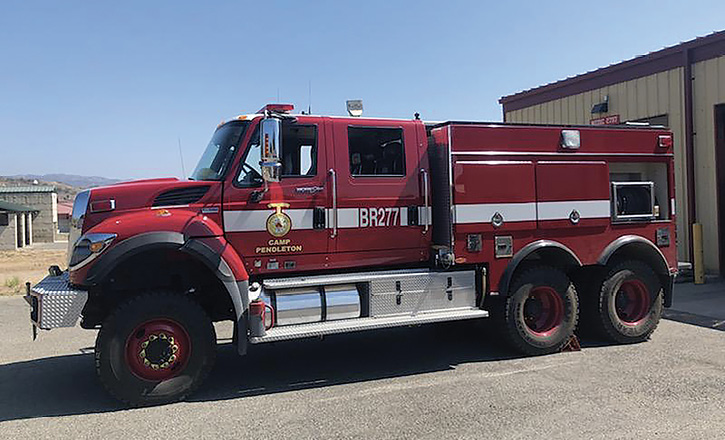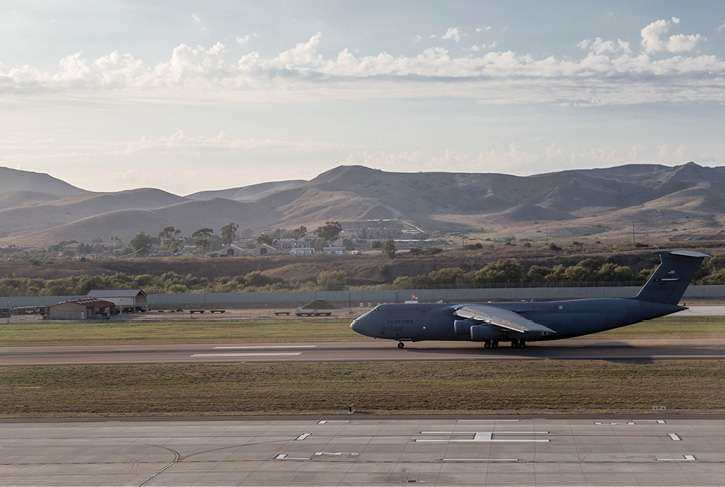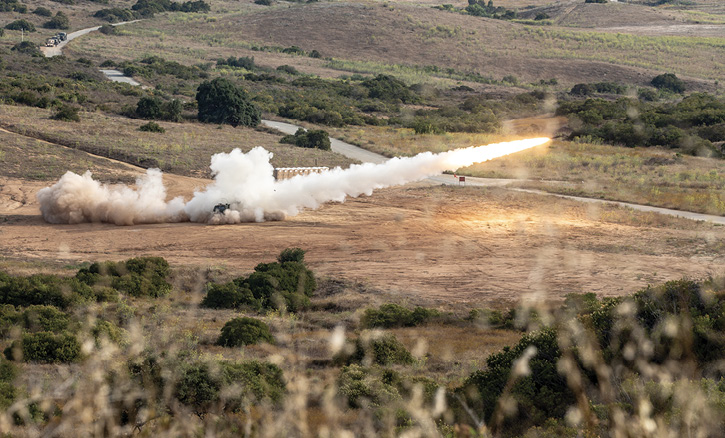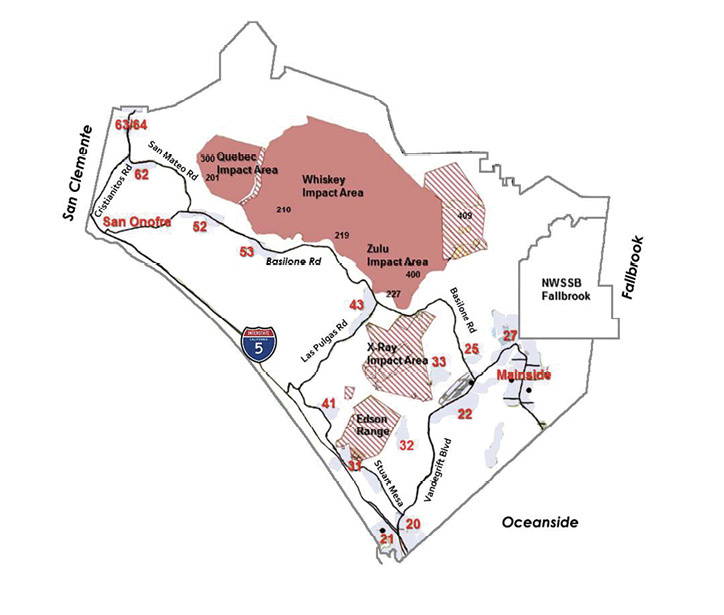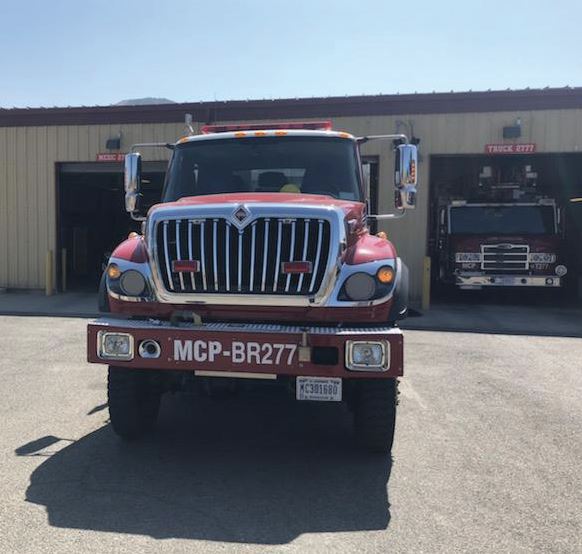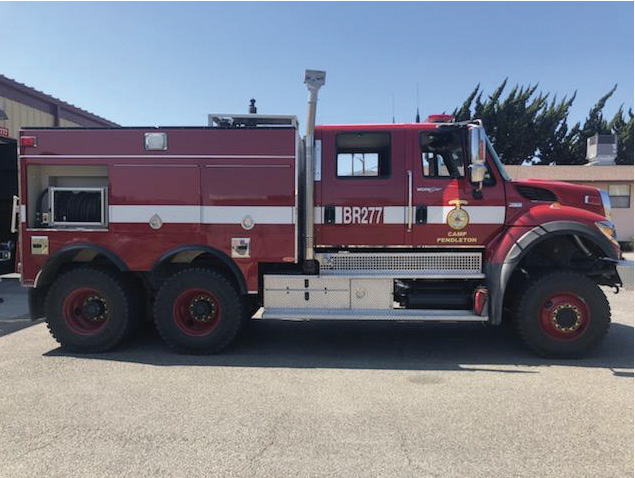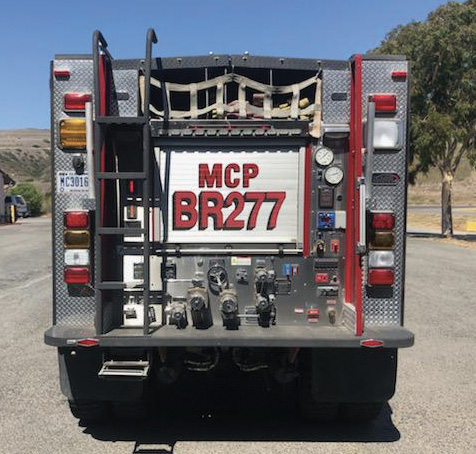Camp Pendleton, home to the United States Marine Corps (USMC) 1st Marine Expeditionary Force’s Training Base and Headquarters for the West Coast and Pacific Area of Operations, is in San Diego County, the southernmost end of California, and Camp Pendleton remains one of the least developed areas of urban San Diego County.
To provide fire protection to more than 195.3 square miles of land, Camp Pendleton has its own on-base fire department, ready to respond to all sorts of emergencies. BR277, a 6×6 KME Brush Truck, makes up just one of the many fire apparatus on this sprawling base.
USMC Communication Strategy and Operations (COMMSTRAT) 1st Lieutenant Charlotte Dennis and Camp Pendleton Fire Department (CPFD) Chief Jeff Moore provided information about BR277 and the base’s terrain.
According to COMMSTRAT, Camp Pendleton is 125,000 acres of rolling, grassy hills to steep mountains with heavy brush, oak trees, streams, lakes, and low flood plain. It also has about 17 miles of coastline with bluffs.
BR277 is designed for Camp Pendleton’s terrain and carries sufficient water and equipment to handle fire suppression within the base with stations strategically located throughout. Because of the distance between each station, the apparatus needs to carry more water and equipment than most brush trucks.
1 BR277 is a four-door 2013 KME built on a Navistar 7500 6×6 chassis. Note the diamond plate side bins for preconnected hoselays, one of two dual side hose reels, the large chrome gas tank, the drip torch on the step running board, and the high ground clearance. (Photos courtesy of USMC Camp Pendleton COMMSTRAT.)
2 This is the type of mountainous and dry terrain that the USMC Camp Pendleton Fire Department fights fires in and how BR277 is ideally designed for this terrain.
The base is prone to grass and brush fires that are sparked by combat training with the Marines firing ammunition and tracers.
To fight fires, the base uses dozers, air resources, hand crews, and Type 3 brush trucks from outside agencies, typically with 500-gallon tanks, according to COMMSTRAT.
Moore says that there are 11 fire stations throughout the base and 10 are staffed full time with 160 civilian firefighters. One station is co-op with the U.S. Forest Service and is seasonal from May 15 to November 15.
Fire personnel respond to wildland fires, structure fires, traffic crashes, hazmat incidents, specialized rescue calls, and just about every incident any city fire department may be asked to mitigate. The main difference is that the civilian-run Camp Pendleton Fire Department serves the USMC.
Moore says the Camp Pendleton Fire Department responds to “range fires” caused by Marines shooting at the firing lines, also sometimes called “munition fires.”
“Putting out the fires allows the Marines to continue training,” Moore says. “The fire sizes can range anywhere from 10 to 15 acres to several thousand acres.
Camp Pendleton’s Brush Truck, BR277, is a 2013 KME built on a 4-door Navistar 7500 6×6 cab and chassis. It is powered by a 330-hp Maxxforce 10 engine and an Allison 3000EVS transmission. Its gross vehicle weight (GVW) is 35,500. It replaced a 2001 6×6 unit.
3 Wildfires can easily start because of live-fire testing and training from the Marines’ guns, artillery, bombing, and missiles.
4 Camp Pendleton covers more than 195.3 square miles of undeveloped land in San Diego County.
To fight fire, it has an 800-gallon water tank with a 25-gallon foam tank, a Darley 250-gpm auxiliary pump with cab controls, and a FoamPro 2001 direct injection foam system. Other equipment includes Harris and Bendix radios and Whelen warning lights.
Although BR277 carries 800 gallons, significantly more than other Type 3 trucks, it still isn’t enough to fight many wildland fires. That’s why Camp Pendleton has hydrants throughout the base for refilling.
Moore says BR277 is a unique brush truck because unlike many other 4×4 two-axle brush trucks used through the United States, it is a triple-axle with dual tires on the rear two axles, giving the truck a total of 10 tires instead of four or six tires on the usual two-axle Type 3 brush trucks.
5 BR277 parked in front of Station 7. Note the bumper headlights and airhorn and the gray plastic coverings where the round frontal headlights should be.
6 A side view of BR277 shows one of two dual side hose reels and the raised exhaust pipe clear of the crew cab, the drip torch on the step running board, and side SCBA compartments.
7 A rear view of BR277 shows the white roll-up door housing hoselays. The left rear ladder leads up to the two hosebeds. BR277 lacks a rooftop water monitor. Each rear axle has four tires. An amber and white rear light provides illumination at night.
The need for a triple-axle brush truck, according to Moore, is to navigate rough terrain and have enough traction to power up the hills and mountains to remote wildfires while carrying 300 more gallons of water than the typical 4×4 500-gallon Type 3 brush truck.
There are three of this kind of brush truck at Camp Pendleton, and the KME BR277 unit is the newest. “[For] the amount of weight of the truck, and the terrain we need to cover, the weight distribution and traction is better on a 6×6,” Moore says. “The Camp Pendleton Fire Department developed the specifications for the truck, but it was purchased by the [U.S.] government.”
Moore says the truck’s design is one of a kind as there is no other like it; however, the spec was developed based on previous department trucks and the Forest Service. “The raised [exhaust] pipe is for firefighter safety based on the crew cab configuration [and] how the firefighters exit and where the truck exhausts.”
The truck has pump-and-roll capability but can also sit as a stationary unit to supply a hoselay, Moore says, adding that as a primary response vehicle, the crew could work for up to 24 hours before being relieved.
The front and rear bumpers are commercial off-the-shelf (COTS) items with no modifications. Hose packs are in the rear compartment and preconnected hoses are in the side, diamond plate compartment. A pair of “barn-style” doors are on top of the truck covering two hosebeds. There are four other compartments on top, two on each side, for additional gear. The truck has sufficient lighting for nighttime operations and amber lights are in place as required for Code 3 responses.
Camp Pendleton has awarded a new contract to KME to replace BR277, and the second generation will have an upgraded power train and transmission. The new brush truck will also have an 800-gallon tank. The new brush truck will have a PTO-driven pump instead of an auxiliary unit.
Moore recalls one instance where BR277 was used effectively to save an on-base housing community. A power surge caused utility poles to spark and set off fires in different locations on a 104°F day with single-digit relative humidity. The fires grew quickly and threatened a child development center as well as a community center. It was one of the few times crews fought a fire with structure exposures.
“It means a lot to the firefighters to be able to protect and serve the community of Camp Pendleton, and they take pride in their efforts to be able to support the Marines [and] their family members who serve and protect us,” Moore says.
Peter Ong is a contributor to Fire Apparatus & Emergency Equipment and Fire Engineering.
